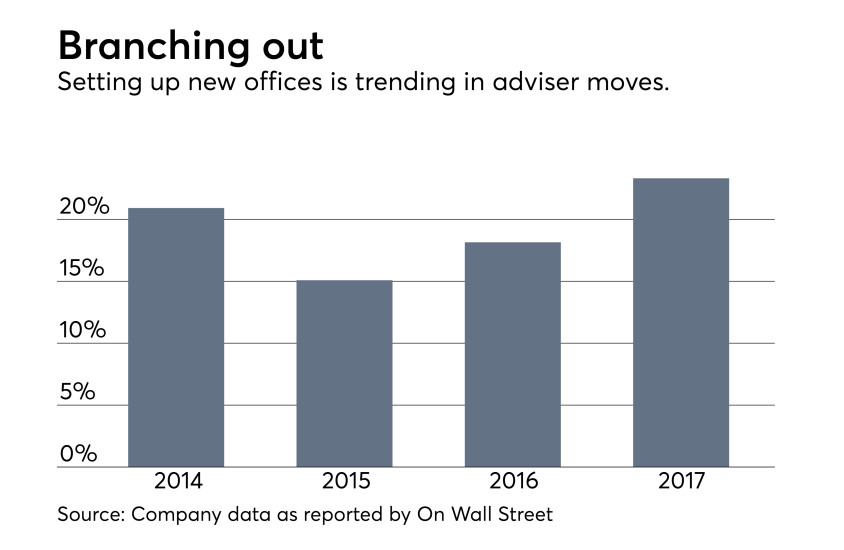
“I have seen more big teams and big producers moving than last year, and I don’t see that slowing down,” says Rob Blevins, president of recruiting firm Rowlett. An aging adviser population, where the average age is between 50 and 60, also means that some brokers may be making one last career change.
Regulatory uncertainty has been an additional factor.
“The landscape has changed dramatically this year, primarily through the DoL’s FAQ last year on the fiduciary rule.” says Mickey Wasserman, president of recruiting firm Michael Wasserman & Associates. The Labor Department's FAQ provided additional regulatory guidance and said that transition deals could be a potential source for conflicts of interest.
Meanwhile, the breakaway movement has been a driving force in 2017. More assets flowed to independent firms in the firm half of 2017 than any six-month periods in the previous three years, On Wall Street found after analyzing recruiting data.
“Independence is going to continue to be strong,” says Blevins.
Overall, recruiters expect advisers to keep moving.
“If you are an adviser that’s considering to move, right now is a good time,” Blevins says, “The deals are still strong. The market is still high. There is never a perfect time but now is pretty good.”
Scroll through to see which firms have found favor with advisers and what new recruitment trends are developing.
Data is based on announced hires at wirehouse, regional and other firms as of June 29, 2017. It does not include independent to independent moves.

Recruiter and coach Elizabeth McCourt, president of McCourt Leadership Group, offers one reason for each. On the one hand, advisers are thinking that “with all the changes in DoL we don’t know what the future might bring so we’d better move now,” she says. On the other hand, she notes that there was a massive recruitment wave in 2008 and 2009, and with those transition deals expiring, advisers are free to move.
The aging of the overall population also played a role, as advisers seize their last chance to move before they retire, according to Blevins. “We have more advisers over 70 than under 35,” he added.
Judging by past years, the coming months of 2017 could see more advisers jumping ship. For the past three years, recruitment activity was always hotter in the second half of the year.

According to Blevins, this general upward trend is no surprise, as there are generally more assets in play than in previous years because of growing AUM. “I’ve been doing this for 18 years,” he said, “and 18 years ago $100 million in assets was like 'wow.'” Average revenue of advisers went up 50% over the past 12 years, from $400,000-$450,000 to $600,000-$650,000, according to Blevins.


McCourt suggests that firms have gotten better at attracting high-net-worth advisers, and that more opportunities at places such as HighTower and Dynasty also played a role.
Wasserman has a more alternative explanation: “Larger advisers are more attractive. Smaller advisers tend to stay where they are.”

“There’s no longer that stigma that independent isn’t as good as traditional retail so that opened door to people going independent,” says McCourt.
The usual reasons to break away, such as restrictions and higher cuts of revenue at big firms, are still factors. But what has changed at big firms this year are the recruitment deals, which according to Wasserman went down to around 250% from around 350% for three of the four wirehouses, making large firms less attractive than they used to be.


“I think a lot of the wirehouses have lost their value proposition,” says Blevins. He also points out that the wirehouses have been focusing on having fewer, yet higher-net-worth advisers.
Wasserman, however, thinks the big four firms will start reversing the downward trend. “As wirehouses position themselves to compete in the recruitment arena,” he says, “new retention efforts of existing advisers at wirehouses are going to take hold in 2018.”



“The trend is towards almost all teams eventually,” says Wasserman. “The solo adviser is quickly becoming a dinosaur right now.”
McCourt gives three reasons why teams are seen as more advantageous for advisers: having partners that can tend to different clients, having a partnership for bigger and better business, and succession planning.
Blevins cites a more subtle reason beyond advisers’ businesses. “Ten to 15 years ago, wirehouses encouraged advisers to form teams,” he says, “they wouldn’t tell advisers this, but I would venture to say that part of the reason is to make it harder for advisers to leave, because if you want to leave you need to convince everyone on the team.”

Recruiters, however, do not see a particular reason for this pattern. “Kids go back to school in the fall, so advisers might have more time,” guesses Blevins.

Recruiters attribute this trend to the breakaway movement. “Major wirehouses are reluctant to set up a brand new office unless someone is ultrahigh-net-worth,” says McCourt, noting that if there is an increase it would be from the breakaway movement. Blevins agrees. “With more advisers going independent you will see more new offices,” he said.





